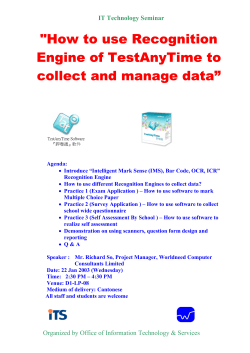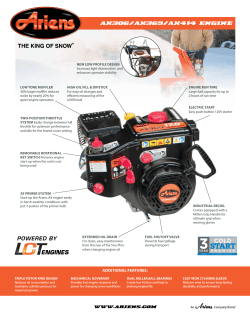
slides
CPSC 439/539
Spring 2014
Wanted: LaTeX Design Editor
Dear students,
The Yale Journal of Economics is seeking a LaTeX Design Editor for the Spring 2014 semester, and we’re inviting
you to apply!
ABOUT THE JOURNAL:
Launched last year with the support of the Economics Department, the Journal showcases outstanding research
in economics by undergraduates at Yale and across the globe. The Journal published its first issue last spring and
its second issue this fall; these issues featured work by students at Yale, MIT, Princeton, and the University of
Chicago on topics like Spotify’s effect on music piracy, laptops in the classroom, and IPO performance. Our work
has reached students and professors across the United States and around the world.
ABOUT THE POSITION:
Our design team is responsible for typesetting and laying out the Journal using LaTeX. We’re looking for a new
design editor who has previous experience using this software and who wants to be part of a new and rapidly
growing publication.
HOW TO APPLY:
Please send an email to yaleeconomicsjournal@gmail.com with your name, college, and class year, as well as
why you’re interested in the position and your relevant experience. Applications will be considered on a rolling
basis. For additional information about the Journal, feel free to email us with questions. We hope to hear from you
soon!
Many slides courtesy of Rupak Majumdar
Additinally, Rupak thanked Alex Aiken, Ras Bodik, Ralph Johnson, George Necula,
Koushik Sen, A J Shankar
This course is inspired by various courses available on-line that combine software
engineering and formal methods
Alex Aiken’s course at Stanford
Darko Marinov’s course at the University of Illinois
Describing a system at a high level of abstraction
A model of the system
Used for requirements and specification
Many notations over time
State machines
Entity-relationship diagrams
Dataflow diagrams
The rise of object-oriented programming
New class of OO modeling languages
By early ’90’s, over 50 OO modeling languages
Three leading OO notations decide to combine
Grady Booch (BOOCH)
Jim Rumbaugh (OMT: Object Modeling Technique)
Ivar Jacobsen (OOSE: OO Soft. Eng)
Why?
Natural evolution towards each other
Effort to set an industry standard
UML stands for
Unified Modeling Language
Design by committee
Many interest groups participating
Everyone wants their favorite approach to be “in”
Resulting design is huge
Many features
Many loosely unrelated styles under one roof
Could also be called
Union of all Modeling Languages
We discuss
Use Case Diagrams
Class Diagrams
Object Diagrams
for functional models
for structural models
Sequence Diagrams
Activity Diagrams
for dynamic models
State Diagrams
This is a subset of UML
But probably the most used subset
Book UML Distilled by Martin Fowler
Elements
Actors
Use
case
Use cases
Relations
Use case diagram shows relationship
actor
between actors and use cases
Use
case
actor
A resource manager manages resources
A project manager manages projects
A system administrator is responsible for administrative functions of the system
A backup system houses backup data for the system
A project manager can add, remove, and update a project
Remove and update project requires to find project
A project update may involve
Add, remove, or update activity
Add, remove, or update task
Assign resource to a task or unassign resource from a task
Describe classes
In the OO sense
Class diagrams are static -- they
display what interacts but not what
happens when they do interact
Each box is a class
List fields
List methods
Train
lastStop
nextStop
velocity
doorsOpen?
addStop(stop);
startTrain(velocity);
stopTrain();
openDoors();
closeDoors();
Many different kinds of edges to
show different relationships
between classes
Mention just a couple
Association between two classes
if an instance of one class must know
about the other in order to perform its
work.
Customer
1
Label endpoints of edge with
cardinalities
Use * for arbitrary
Can be directional (use arrows in
that case)
*
Order
An association in which one
class belongs to a collection
Shared: An object can exist in more
than one collections
No ownership implied
Denoted by hollow diamond on
the “contains” side
An association in which one
class belongs to a collection
No Sharing: An object cannot exist
in more than one collections
Strong “has a” relationship
Ownership
Denoted by filled diamond on
the “contains” side
Car
1
Project
1
4
Wheels
1..*
Consultant
Car
1
Project
1
4
Wheels
1..*
Consultant
CPSC439
1
AKW
1
*
Student
1..*
classroom
CS439
1
AKW
1
*
Student
1..*
Classroom
Inheritance between classes
Button
Denoted by open triangle
RequestButton
EmergencyButton
(Think subclassing)
Hospital Doctor
Cardiologist
Doctor
General
Practitioner
final class Car {
final class Car {
private Engine engine;
private final Engine engine;
void setEngine(Engine engine) {
this.engine = engine;
}
Car(EngineSpecs specs) {
engine = new Engine(specs);
}
void move() {
if (engine != null)
engine.work();
}
void move() {
engine.work();
}
}
}
Object diagram is an instantiation of a class diagram
Represents a static structure of a system at a particular time
Now obsolete (link)
Invalid
Object
Diagram
33
Sequence diagrams
Refine use cases
Gives view of dynamic behavior of classes
Class diagrams give the static class structure
Not orthogonal to other diagrams
Overlapping functionality
True of all UML diagrams
Class roles: roles that objects play
Lifelines: the existence of an object over time
Activations: time during which an object is performing an operation
Messages: communications between objects
link
Reincarnation of flow charts
Uses flowchart symbols
Emphasis on control-flow
Order (input parameter)
Order (output parameter)
How will you model the following situation:
In parallel, you accept payment and send order to warehouse to be delivered.
Then the warehouse throws an exception to denote product is not available
Then you must put back the charge on the CC
In general, how do you handle exceptions?
Swimlanes: responsibility of one or more objects
Action states: steps in the execution of an algorithm
Action flows: relationship between the different action states
Object flow: utilization of objects by action states
Hierarchical finite automata
Invented by David Harel, 1983
Specify automata with many states compactly
Button
off
push
depart
on
We discussed
Use Case Diagrams
Class Diagrams
Object Diagrams
for functional models
for structural models
Sequence Diagrams
Activity Diagrams
for dynamic models
State Diagrams
This is a subset of UML
But probably the most used subset
A common language
Makes it easier to share requirements, specs, designs
Visual syntax is useful, to a point
A (good) picture is worth 1000 words
For the non-technical, easier to grasp simple diagrams than simple pseudo-code
To the extent UML is precise, it forces clarity
Much better than natural language
Commercial tool support
Something natural language could never have
Hodge-podge of ideas
Union of most popular modeling languages
Sublanguages remain largely unintegrated
Visual syntax does not scale well
Many details are hard to depict visually
Ad hoc text attached to diagrams
No visualization advantage for large diagrams
1000 pictures are very hard to understand
UML is being widely adopted
By users
By tool vendors
By programmers
A step forward
Seems useful
First standard for high-levels of software process
Expect further evolution, development of UML
Decide on a high-level specification
E.g., Structure of the government in the US, or your own system of choosing classes to
attend this semester
Work in groups of 3-4
No talking or writing in any natural language
ONLY using UML to communicate, see if you can come up with a thorough design of
the system so that all of you agree on the design of the system
© Copyright 2025















